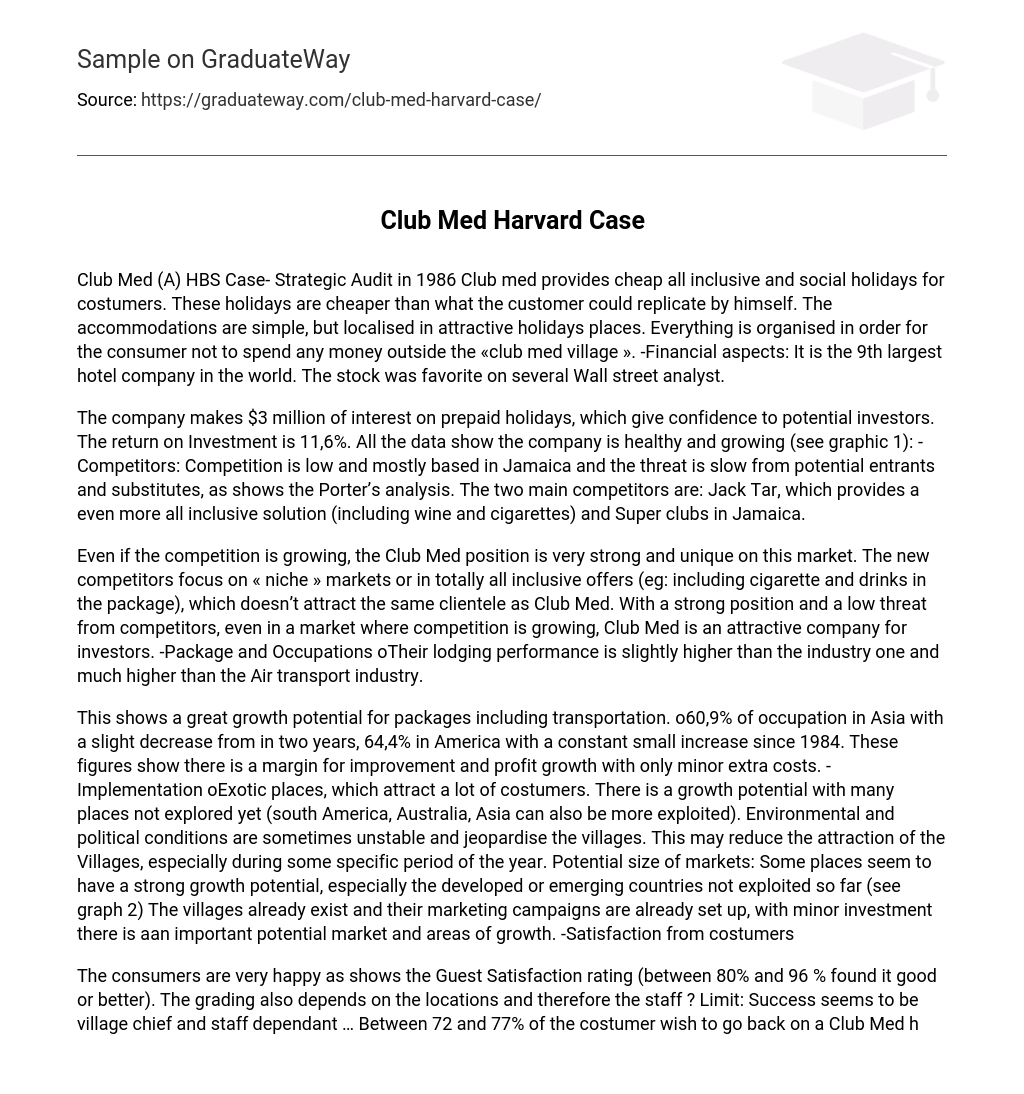Club Med (A) HBS Case- Strategic Audit in 1986 Club med provides cheap all inclusive and social holidays for costumers. These holidays are cheaper than what the customer could replicate by himself. The accommodations are simple, but localised in attractive holidays places. Everything is organised in order for the consumer not to spend any money outside the «club med village ». -Financial aspects: It is the 9th largest hotel company in the world. The stock was favorite on several Wall street analyst.
The company makes $3 million of interest on prepaid holidays, which give confidence to potential investors. The return on Investment is 11,6%. All the data show the company is healthy and growing (see graphic 1): -Competitors: Competition is low and mostly based in Jamaica and the threat is slow from potential entrants and substitutes, as shows the Porter’s analysis. The two main competitors are: Jack Tar, which provides a even more all inclusive solution (including wine and cigarettes) and Super clubs in Jamaica.
Even if the competition is growing, the Club Med position is very strong and unique on this market. The new competitors focus on « niche » markets or in totally all inclusive offers (eg: including cigarette and drinks in the package), which doesn’t attract the same clientele as Club Med. With a strong position and a low threat from competitors, even in a market where competition is growing, Club Med is an attractive company for investors. -Package and Occupations oTheir lodging performance is slightly higher than the industry one and much higher than the Air transport industry.
This shows a great growth potential for packages including transportation. o60,9% of occupation in Asia with a slight decrease from in two years, 64,4% in America with a constant small increase since 1984. These figures show there is a margin for improvement and profit growth with only minor extra costs. -Implementation oExotic places, which attract a lot of costumers. There is a growth potential with many places not explored yet (south America, Australia, Asia can also be more exploited). Environmental and political conditions are sometimes unstable and jeopardise the villages. This may reduce the attraction of the Villages, especially during some specific period of the year. Potential size of markets: Some places seem to have a strong growth potential, especially the developed or emerging countries not exploited so far (see graph 2) The villages already exist and their marketing campaigns are already set up, with minor investment there is aan important potential market and areas of growth. -Satisfaction from costumers
The consumers are very happy as shows the Guest Satisfaction rating (between 80% and 96 % found it good or better). The grading also depends on the locations and therefore the staff ? Limit: Success seems to be village chief and staff dependant … Between 72 and 77% of the costumer wish to go back on a Club Med holiday, this shows that the Club Med’s offer still fit it’s costumer’s requirement and show a potential expansion for the company. -The marketing : They sell a whole package, directly to he consumer (B2C) or through travel agents (B2B).
They also focus on a limited number of travel agency (2000 book 50 % of the indirect sales) and train the travel agents to sale their products. This close marketing relying on personal advising is a key component for success. However, it requires a lot of investment (regular trainings) and we may wonder if it will last. Therefore, I would recommend to invest in this company, however some constraints must be taken into account: > Even if more than 70% of the clients wish to come back, the client expectations might change and the company will have to anticipate these changes to be able to last on this market. In North America, the market growth potential is 334%, and there were no investment made in this area (number of bed stagnant to 470); a clear development strategy and competitors analysis in this particular region could be beneficial. > The 60% average occupation show a growth potential but could also be a warning towards years to come. Is the Club Med proposal still adapted to the market? > The Club Med is implemented on several continents, which opens opportunities for growth but it is also a risk for too many diversifications and is weaknesses. Staff limits: with the high turnover. > Local government who might not accept for long the pressure of Club Med and might be more reluctant to finance the Villages and accept foreign labour. ANNEXES Graph 1 : Net income/Sales, net income / guest, Sales / guest and net income of Club met betwwen 1981 and 1986 oThe Net income/guest is, slightly but continiously, growing form 1982 and 1986 (from 36 to 54), so are the net income/sales and the net income. The Sales/guest are a little more fluctuating, however remaining around $1,000. oThe company is reasonably investing (29% of debt) which shows potential expansion. Graph 2: Potential size market in various countries oSuch as UK and Ireland, West Germany, Scandinavia, the Netherlands and Spain, with a total of 75 % potential growth in Europe. oThe USA and Canada : oAsia and South Africa : especially Japan, Australia, Hong Kong, Taiwan and South Agrica There are many potential new markets and imprvement for the Club Med.





